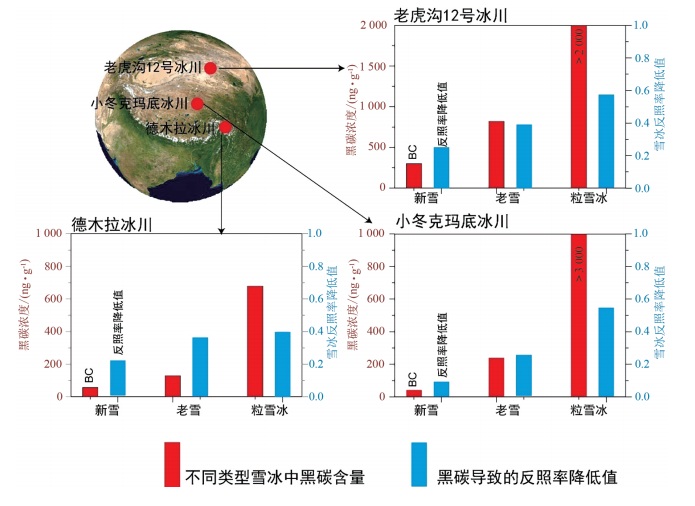碳质气溶胶(黑碳和有机碳)对全球气候变化及加速冰川消融具有重要影响,已引起广泛关注并开展了许多相关研
究。基于目前的研究进展,综述了第三极地区雪冰中碳质组分的空间分布特征,发现老雪和粒雪冰中黑碳与有机碳含量显
著高于雪坑以及新雪,更新了我们对于同一条冰川不同区域雪冰中碳质组分的认识。雪坑中黑碳的同位素组成揭示,青藏
高原东北部雪冰中黑碳主要来自化石燃料贡献,而高原中部主要来源于生物质燃烧,喜马拉雅山脉南坡雪冰中黑碳的化石
燃料贡献与生物质燃烧的贡献相当。雪冰中碳质组分导致的辐射强迫可达上百W•m−2,由此使得冰川消融增加、积雪持续
期缩短。下一步将继续加深对雪冰碳质组分的来源及其对反照率影响的机理研究,为进一步预测气候变暖背景下碳质组分
对冰川消融的贡献提供科学基础。
Carbonaceous components (e.g., black carbon (BC), organic carbon (OC)) play an important role on the global climate
change and enhancing the glacier melt, which has triggered out a lot of interest and related studies. Based on the recent research of this
topic, we reviewed the spatial and temporal characteristics of carbonaceous components in snow and ice in the Third Pole region. The
results indicated those BC and OC concentrations in aged snow (or firn ice) showed much higher than that in snowpit and fresh snow,
which enhanced our understanding on the carbonaceous component in different snow types in one entire glacier. Isotopic signature
of BC in snowpit revealed that BC deposited on glaciers in the northern Tibetan Plateau mainly originated from anthropogenic
emissions. However, in the central plateau, BC from biomass burning combustion contributed largely to the BC deposition on glaciers.
In Himalayas, equal contributions from fossil fuel and biomass combustion to BC in snowpit were found. Radiative forcing caused
by BC can reach to hundreds of W·m-2, further accelerating the glacier melting and reducing snow cover duration days. In the future,
studies on the sources of carbonaceous components and their impact on the radiative forcing should be enhanced. These results will
be served as a valuable scientific basis for the forecasting contributions of carbonaceous components to glacier melting under climate
change.




